Cantor's Diagonal Argument
A Most Merry and Illustrated Explanation
(With a Merry Theorem of Proof Theory Thrown In)
(For a more lengthy version of this essay, click here.)
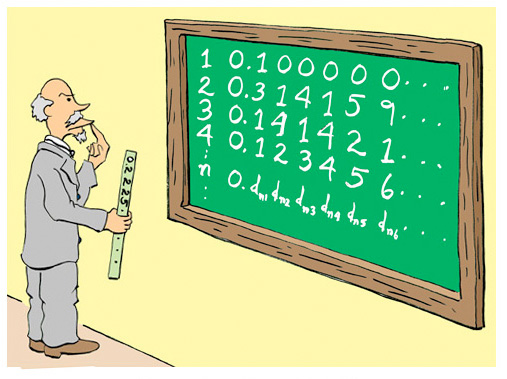
George showed it wouldn't fit in.
A Brief Introduction
Not too long ago while surfing the TV channels, you could lean back, press the remote, and suddenly you found a show about Georg Cantor (pronounced "GAY-org", but we'll call him "George"). George was a mathematician - perhaps the most important mathematician in the 19th century and some say of all time.
George's most famous discovery - one of many by the way - was what we call the diagonal argument. Although George used it mostly to talk about infinity, it's proven useful for a lot of other things as well, including the famous undecidability theorems of Kurt Gödel.
Counting the Infinite
George's interest was not infinity per se. What he was doing was developing set theory.
Pretty much everyone accepts that some sets are infinite. The sets of counting numbers, integers, and the points on a line are all infinite.
But the concept of infinity was not well defined. Just saying an infinite set is unlimited is simply saying an infinite set is infinite. So George decided he needed to come up with a precise mathematical definition.
George started things off simply. He just considered the counting numbers.
N = { 1 , 2 , 3 , 4 , ..... }
George realized that the counting numbers had no upper limit. Otherwise you could add 1 to the highest number and not get a higher number. But that was absurd. If you add 1 to any number, you'll always have a higher number.
This property - that every counting number has an immediate successor - is how George defined the infinity of the counting numbers. He named this infinity a countable infinity.
George, though, also stumbled on some oddball properties of countably infinite sets. For one thing sometimes only a small portion of a countably infinite set is also countably infinite.
Now most people would say there are only half as many even numbers as counting numbers. But George showed you can put both the counting numbers and the even numbers into a one-to-one correspondence1.
Footnote
This type of one-to-one correspondence was noticed by none other than Galileo in 1638 but even in a stranger way. Galileo pointed out that each number could be paired off with its square:
| 1 | → | 2 |
| 2 | → | 4 |
| 3 | → | 9 |
| 4 | → | 16 |
| 4 | → | 25 |
| ⋮ | ||
| n | → | n2 |
| ⋮ |
What Galileo thought was odd was that as n increases, the squares, n2, are separated by more and more numbers - that is, they become sparse. But the size of the two sets are clearly the same.
| 1 | → | 2 |
| 2 | → | 4 |
| 3 | → | 6 |
| ⋮ |
This is an odd finding because putting elements of a set into a one-to-one correspondence is how we count the members of any set. If you pair the elements of a set with as many sequential counting numbers as possible, then the highest counting number of the pairings is the set's size.
So we see that for the set { 1 , 89 , 1234 }, the size is 3.
| 1 | → | 1 |
| 2 | → | 89 |
| 3 | → | 1234 |
And so the counting numbers and even numbers - infinite sets though they are - with their one-to-one correspondence:
| 1 | → | 2 |
| 2 | → | 4 |
| 3 | → | 6 |
| 4 | → | 8 |
| 5 | → | 10 |
| ⋮ | ||
| n | → | 2n |
| ⋮ |
... must also be the same size.
This is a weird property. We have a set - the counting numbers - which is the same size as one of its own proper subsets, the even numbers2. In finite sets, a proper subset is always smaller than the original set.
Footnote
A set A has a subset, B, if every element of B is also an element of A. Since by this definition, every set is a subset of itself, we also define a proper subset.
A set A has a proper subset B if every element of B is also an element of A but every element of A is not an element of B.
So for the set { 1 , 89 , 1234 }, both:
{ 1 , 89 , 1234 }
... and ...
{ 89 , 1234 }
... are subsets. But:
{ 89 , 1234 }
... is a proper subset.
The other proper subsets for { 1 , 89 , 1234 } are { 1 }, { 89 }, { 1234 }, { 1 , 89 }, { 1 , 1234 }, and the empty set { } (also represented as ∅.
Another weird property is that if you combine a countably infinite set with another countably infinite set, the new set is also countably infinite. So both sets are the same size.
We see this if we consider the set of integers.
The set of integers is simply the counting numbers (ergo, 1, 2, 3, etc.) grouped with their negatives (-1, -2, -3, ...) and zero. You'd think there would be more integers than counting numbers.
But you can prove the number of integers is the same as the counting numbers simply by setting up the following one-to-one correspondence.
| 1 | → | 0 |
| 2 | → | -1 |
| 3 | → | 1 |
| 4 | → | -2 |
| 5 | → | 2 |
| 6 | → | -3 |
| 7 | → | 3 |
| ⋮ |
You can write this correspondence as an actual formula:
f(n) = (-1)(n+1)n/2 - [(1 - (-1)(n)])/4
... where if you plot each counting number, n, against f(n) you get the one-to-one correspondence of the counting numbers to the integers we show above.
Try this formula. Like the commercials say, it really, really works.
And finally - although it's a little more complex and strange - George showed that the fractions - the rational numbers - are also countably infinite3.
Footnote
At this point, we have to admit that although we have shown the formulas for the one to one correspondence of counting numbers and the other sets, we have not actually proven the formulas are correct. This would require a process called mathematical induction. It can be a bit tricky but not so tricky that the average person can't understand it. For a Most Merry and Illustrated Essay with an introduction to induction click here.
Things were certainly getting very strange.
George Figures It Out
What stamped George as a great mathematician is he didn't worry about the strange results (although some of his colleagues did). Since the weird conclusions came from proper reasoning, he just accepted them.
But some things had to be clarified. George realized that saying countable infinite sets were the same size was not precise. Instead of talking about the size of a set, George spoke about a set's cardinality.
There was, though, no actual number for the "cardinality" of a countably infinite set. The usual symbol for infinity, ∞, was too vague. So George decided to borrow the Hebrew letter aleph, ℵ, and he called the countable infinity cardinality, ℵ0, or aleph-null.
Why did George add the zero subscript? Well, he began to think that a countable infinity was the tip of an infinite iceberg. And that's when he came up with the diagonal argument.
The PROOF
George's diagonal proof, we should mention, is an indirect proof. That is, you:
 |
Assume the opposite of what you want to prove. |
 |
Start to reason until you come to a statement we know is FALSE. |
 |
Then we know (so the logicians tell us) the opposite of what we tried to prove is incorrect. |
 |
So what we wanted to prove in the first place is true, after all!4 |
Footnote
The proof that indirect proofs are valid is quite simple using symbolic logic.
Suppose you're trying to prove a statement S. Then you first assume ¬S.
Next you assume that ¬S implies a CONTRADICTION, A ∧ ¬-A.
This is written symbolically as:
¬S → A ∧ ¬A
Using the rules of symbolic logic we find:
¬S → A ∧ ¬A
¬(¬S) ∨ (A ∧ ¬A)
¬¬S ∨ (A ∧ ¬A)
S ∨ (A ∧ ¬A)
Since a contradiction, A ∧ ¬A, is always FALSE, we now have:
S ∨ FALSE
Since TRUTH of:
¬S → A ∧ ¬A
... is assumed to be TRUE, then:
S ∨ FALSE
... is likewise TRUE.
So that S is TRUE follows immediately.
We'll see that this is what George did. And in doing so he invented the diagonal argument.
The diagonal argument starts off by representing the real numbers as we did in school. You write down a decimal point and then put an infinite string of numbers afterwards. So you can represent integers, fractions (repeating and non-repeating), and irrational numbers by the same notation.
| Type of Number | Representation |
| Integer | 1.0000000000000000000000000.......... |
| Non-repeating fraction | 0.2500000000000000000000000.......... |
| Repeating fraction | 0.1231231231231231231231231.......... |
| Irrational Number | 1.4142135623730950488016887......... |
Remember George was using an indirect proof, and he wanted to prove you could not put the real numbers into one-to-one correspondence with all the counting numbers. So he assumed you could.
To make things simpler, though, he restricted the real numbers to those between 0 and 1. If those numbers can't be put into a one-to-one correspondence with counting numbers, then the rest of the points on an infinite line sure can't either.
A partial list of the one-to-one correspondence might look something like the following table. Again this isn't to be taken too literally but is simply a hypothetical example.
|
(Hypothetical) Place in List |
Number |
| 10 | 0.00000000000000000000000.......... |
| 128931 | 0.50000000000000000000000.......... |
| 583910 | 0.41421356237309504880168.......... |
| 3291293 | 0.51515151515151515151515......... |
| 78481839 | 0.71828182845904523536028.......... |
| 948118319 | 0.14159265358979323846264.......... |
But partial hypothetical lists won't help us prove the theorem. What we need is a more general representation, all the better to reason with.
So what we do is dream up a symbolic list. Ergo:
| Place in List | Number |
| 1 | 0.d11d12d13d14d15d16d17d18d19 .... |
| 2 | 0.d21d22d23d24d25d26d27d28d29 .... |
| 3 | 0.d31d32d33d34d35d36d37d38d39 .... |
| 4 | 0.d41d42d43d44d45d46d47d48d49 .... |
| 5 | 0.d51d52d53d54d55d56d57d58d59 .... |
| ⋮ | |
| n | 0.dn1dn2dn3dn4dn5dn6dn7dn8dn9 .... |
| ⋮ |
Now if it is true there is the one-to-one correspondence with the counting and real numbers, then it will be impossible to find another real number that's not in our list.
But what happens if we do find another real number? Well, then we've found our contradiction.
And if we find a contradiction, that means our initial assumption - that there is the one-to-one correspondence of counting and real numbers - can't be true.
And that would mean that the infinity of the real numbers is not the same infinity as the counting numbers. That is the two sets do NOT have the same cardinality.
In fact, it turns out our mysterious new number is very easy to write. Call it m and define it as:
m = 0.(d11+1)(d22+1)(d33+1)(d44+1)(d55+1)(d66+1).....(dnn+1)....
In other words. take the diagonal elements of the original list - that is, take d11, d22, d33, d44, d55 and all the rest - and then add one to them. Then line them up after a zero and a decimal point.
This is a real number. And if our assumption that the real numbers and counting numbers have a one-to-one correspondence it true, then m must be somewhere in our original list.
(Strictly speaking, what we do is slightly more complicated. If dmm is 0 through 8, then we substitute dmm + 1 for dmm. But if dmm = 9, the dmm becomes 0).
Does It Fit?
All right. Just where does our number m fit in the list?
Well, it can't be the first place because the first number after the decimal point is d11, and m has (d11+1).
It can't be the second place either since the second number is d22. And m has (d22+1).
Third place? Nope. That has d33; m has (d33+1).
It's the same for any number you pick. There is no place in the whole list where you can put the new number, m. Therefore for any counting number n the new number cannot be put in the list since the original list had dnn and our new number always has (dnn+1).
We have the contradiction of the indirect proof.
And the consequence?
 |
The counting numbers canNOT be put into a one-to-one correspondence with the real numbers. |
... which also means:
 |
The counting numbers and the real numbers do NOT have the same cardinality. |
At this point it's tempting to say, "Well, you can add one element to a countably infinite set and still have a countably infinite set. So we'll advance every number by one place, and stick in the new number. So now we have our one to one correspondence with the counting numbers.
Well, that doesn't work either. You can still take the new diagonal, add one to each number, and come up with a number that's not in our new list. You can't win, and the real numbers and counting numbers cannot be put in a one-to-one correspondence.
The lack of the one-to-one correspondence of the real numbers and counting numbers means there's too many real numbers to count. Now that means we have two types of infinity. One is countable (for the counting numbers) and the other infinity (for the real numbers) is uncountable.
Calling a spade a spade, George called this new and uncountable infinity an uncountable infinity. And it turns out a lot of sets are uncountable: the real numbers, the number of points on a line, the number of points on a plane; stuff like that.
Since our uncountable infinity is larger than the earlier infinity, ℵ0, George called its cardinality, aleph one, ℵ1.
How are the two infinities related? As we'll show below George decided there was a formula:
ℵ1 = 2ℵ0
This equation formed the basis of what George called the continuum hypothesis. The continuum hypothesis posited that there were no infinities between ℵ0 and ℵ1. That is, there is no set whose cardinality is between that of the counting numbers and the real numbers.
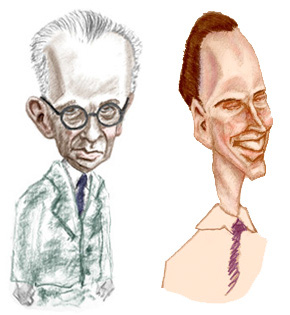
Kurt and Paul
They finally solved it.
Despite George's efforts to prove the continuum hypothesis, he had no luck in doing so. That's because it can't be proven. That was shown by two 20th century mathematicians. In 1940, Kurt Godel showed the continuum hypothesis cannot be disproven with the set theory axioms. Then in 1963 Paul Cohen proved it can't be proven either.
That means the continuum hypothesis is like Euclid's fifth proposition. It is independent of the other axioms of set theory. If you want, you can create a set theory where the continuum hypothesis is true. Or you can create a set theory where it is not.
Objection! Objection!
The diagonal argument bothers a lot of people, and you will find much brouhaha on the Fount of All Knowledge (i. e., the Internet) that attempts to prove it is wrong. The objections, though, can be distilled down to simple and subtle misunderstandings.
As we mentioned before, the most common objection is that you should be able to bump-up-the-numbers and slip in the new diagonal number. So you still have a countable infinity.
But George's Friends point out this is a never ending goose chase. When you bump up a number to slip a new one in, with the diagonal method you can then create new number that's not in the list. So bumping up numbers doesn't help.
Of course, the George Objectors say, well, just bump the numbers up again. Then you can slip in a new number and again get your one-to-one correspondence.
And it goes on and on.
Which argument is right? Does the never ending goose chase mean you can slip a new number in? Or doesn't it?
Actually the goose-chase/number-bumping argument is irrelevant. Instead, to prove George wrong, the George Objectors have to show that once you make a one-to-one correspondence of the real and counting numbers, you can never create a new number that's not in the list.
But the diagonal argument shows that you can. So George was right and there's nothing we can do about it.
George the Effective
At this point we'll say there are mathematicians - quite legitimate ones - that don't accept George's proof. That's because in creating his proof he just waved his hands and said "Let there be a one-to-one correspondence". He just pulled it out of his hat.
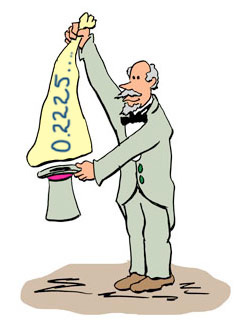
George could have pulled it out of his - ah - hat.
These critics are call Intuitionists and point out that George did not construct the correspondence between counting numbers and a unique real number. Until he does that, they say, George's theorem is at best incomplete.
It is actually quite simple to construct a series of unique real numbers that are paired to each counting number. To do so we'll add some rigor here and point out that our pairing is actually a function. This function maps the counting numbers to a unique real numbers.
To middle school students a function is a formula that you have to plot on a graph. But more generally and rigorously, a function is an ordered pair of numbers. In our case, the first number of the pair is a counting number and the second number is a unique real number. Our function is the set of all such ordered pairs.
More exactly we define our function as:

A bit of explanation is clearly in order. What the formula above means is we have defined a set of ordered pairs (x, yx) where x is a member of the counting numbers (the script N stands for the alternative name of the counting numbers, the natural numbers). This means that there are as many ordered pairs as counting numbers.
The second element of the ordered pair yx is defined as:

The part of this equation, yxi, is in turn defined as:
yxi = RND( {0, 1, 2, 3, 4, 5, 6, 7, 8, 9} )
That is, yxi is simply a single digit from 0 to 9 but randomly selected.
Knowing that the capital letter Sigma, Σ, represents summation, we see that yx is a number represented by a decimal point followed by a random infinite series of the digits from 0 to 9. Ergo, the ordered pair (x, yx) has a counting number for the first number and a real number for the second.
But are the numbers unique? Can't two of the numbers be the same simply by chance?
Fortunately, the answer is no. Consider two numbers. Call them, yr and ys. We will define them as we did yx but sum over a finite number, k, of randomly chosen digits.
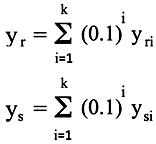
For instance, if k = 10, then yr and ys could be.
yr = 0.4408754017
ys = 0.8598501984
Now of course if we kept trying we would eventually end up with two values that happen to be equal.
yr = 0.5200845709
ys = 0.5200845709
But just what is that probability of this happening? That is, how often will yr and ys will be the same?
Well, that's easy enough to calculate. Since we have k digits (here k = 10), the probability that two series of digits of length k are equal is given by:

That is, if, we have two series of numbers that are 2 digits long, the odds that the numbers are equal is 0.01. If they have three digits, then the odds are 0.001 they will be the same. With 10 digits (as we have in our example) we have a probability 0.0000000001.
So if yr and ys have an infinite number of digits:
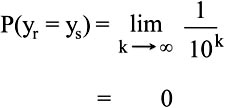
This means that with our definition of yx as an infinite number of random digits after the decimal point, no two yx values can ever be the same. Ergo, each yx will be unique.
(Note: We emphasize that if k is a finite number, there is some probability that two numbers will not be unique. Then if you create enough yx values, eventually you'll find two that are the same. This is the famous Birthday Problem but generalized.)
What we have done here is not just make a hypothetical "assume there is a one-to-one correspondence, etc. etc." generalization. Instead, we have defined an effective method for generating unique real numbers, each of which can be assigned to a unique counting number.
Although you can't write out the entire real number - it's infinitely long after all - you can find what any digit is at any location in the real number. Pick the digit and generate a random number. That's your digit for that number at that location.
But ... but, George's critics say. You don't know what the random number is until you generate it after you've already generated it! So when you find out what the number is, it won't be the same number.
Well, not really. You can, if you wish, look at the issue in a modernistic manner in which the instance does not occur without the observation. Sort of the mathematical analog of Schrödinger's Cat.
In any case it doesn't matter. The properties derived from a sufficiently large collection of random numbers will be the same regardless of the individual values. That is, if you have generated enough random numbers for obtaining a general characteristic of the ensemble, then replacing the original random numbers randomly will not change the property therein determined (using big words here). Ergo, you're gonna get the same answer no matter when you take a peek.
A Useful Application
Today the majority of mathematicians accept the diagonal argument and its proof of the existence of countable and non-countable infinities. The different infinities not only make a lot of sense but also lead to many interesting - and some say profound - conclusions about the world.
For instance, don't you think it would be great to prove there are true statements that cannot be proven? Certainly a lot of clergymen, politicians, and parents would like to think so. And if we accept the diagonal argument, we can do just that.
Remember we've proven that there are more real numbers than counting numbers and that the subset of all counting numbers is also not countable. And with George's work we now set out to prove there are more truths in the universe than we can prove.
But first we need to decide what it means to prove something. And to do that we need to know what we mean by a theorem.
In math or logic, when you want to prove something you have to start with a set of premises. In math these are axioms or previously proven theorems. Then by deductive reasoning you arrive at your conclusion.
Now if you do this right, each step of your reasoning is either an axiom, a previously proven theorem, or a new statement derived (correctly) from one or more of the previous steps. Eventually (if you're correct) then the last step in your line of reasoning will be the final conclusion you want. That last line is the theorem. The whole list of symbols from top to bottom is your proof.
The simplest and most boring "proof" in the history of mankind began with Aristotle. But it shows the difference between a proof and a theorem.
| All men are mortal. |
| Socrates is a man. |
| Socrates is mortal. |
In this case the theorem is the final sentence. "Socrates is mortal." That's what you have proven. The proof is the list of sentences that lead to the final statement.
In essence then a proof is a list of statements arrived at by a given set of rules. Whether the theorem is in English or another "natural" language or is written symbolically doesn't matter. What's important is a proof has a finite number of steps and so uses finite number of symbols.
Now it is true that the number of symbols is open ended. If you don't want to use English you can use mathematical and logical symbols. In that case, you can have an unlimited number of variables which can be written as x0, x1, x2, ... and so on forever.
But at most we can only use a countably infinite number of symbols. So any theorem must be shorter than a countably infinite number of steps and the limit of symbols is likewise countably infinite.
So no matter how many theorems we prove, books we write, or politicians give speeches, the symbols used will always make at most a countably infinite list. So at most there are only a countably infinite number of mathematical theorems and so only a countably infinite set of proofs.
So now as the $500 an hour psychiatrist said after a year of twice a week sessions, we can begin, yes?
OK. Let's take the set of counting numbers and make the power set. That is, we make all possible subsets of the counting numbers.
Then pick a number, any number. We'll pick the number "1". Then for every subset it will be either true or false that "1" is a member of that particular set. So there is at least one true mathematical statement associated with each subset of the counting numbers.
But wait. How many truths do we have? Well, we have just shown that the number of subsets of the counting numbers is uncountably infinite. So there must be an uncountable number of true mathematical statements.
But remember what we said above? We only have a countable number of theorems. So:
 |
There are not enough theorems to prove all the true mathematical statements. |
Yes, Virginia, there are true mathematical statements that can't be proven.
How about that?
References
Georg Cantor: His Mathematics and Philosophy of the Infinite, Joseph Dauben, Princeton University Press, 1990.
Galileo: Two New Sciences, Galilei, Galileo, Stillman Drake (Translator), University of Wisconsin Press, 1974.
"A Crash Course in the Mathematics Of Infinite Sets", Infinite Reflections, Peter Suber, Peter Suber. Department of Philosophy, Earlham College, Published in St. John's Review, Volume 44, Issue 2, 1998, pp. 1-59.
"Constructive Mathematics", Stanford Encyclopedia of Philosophy, Tuesday, November 18, 1997 (Revised: Wednesday, May 30, 2018.
"Constructive Mathematics", Douglas Bridges and Erik Palmgren, Stanford Encyclopedia of Philosophy, Tuesday, November 18, 1997 (Revised: Wednesday, May 30, 2018).
"Intuitionistic Logic", Joan Moschovakis, Stanford Encyclopedia of Philosophy, Wednesday, September 1, 1999 (Revised: Tuesday, September 4, 2018).
Metalogic: An Introduction to the Metatheory of Standard First Order Logic , Geoffrey Hunter, University of California Press, (1973).
As hard as it is to believe, there are many people who think that the CooperToons Merry Histories and Educational Essays are written in a spirit of sarcasm and in fact are satires of scientific, philosophical, and theological writings. But a quick perusal of Geoffrey's book (just the first chapter for crying out loud) will show you that the proof given in such painful length and detail above is essentially that which Geoffrey gives us with much less wind.
Geoffrey's book is intended for people who have some introduction to formal logic but otherwise its for the layman who is interested in going beyond the "Socrates is mortal" type schtick. As he points out, if you take a logic course in college they usually end before you get to studying the interesting stuff.
An alternative proof, by the way, to show there are true statements with no proof is to realize you have specifiable sets which can be expressed as a formula, and there are other sets which cannot be specified as a formula.
For instance the set of even numbers, E, is defined as:
E = {x: x = 2n where n = 1, 2, 3, ...}
This is read as "The set E is the set of all x such that x = 2n where n = 1, 2, 3, ...
So in general a set, S, is specifiable if you can write it like:
S = {x: P(x)}
where P(x) is a formula you can plug x into and get a member of the set.
Now you can only prove an element is in a set if the set is finite - which means you can check each element if you have the time - or if you have a formula for determining if the element satisfies the equation. But there are only a finite number of formulas or at best a countably infinite number of formulas. As we showed there are uncountably infinite sets, there are sets without an associated formula and yet are infinite. So you there are some sets where you can't tell if a given number is a member or not - even though it is. So once more we have more true mathematical statements than we have proofs.
Dangerous Knowledge, BBC, 2007, Internet Movie Data Base.